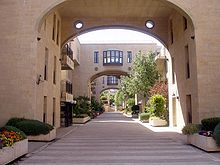Mamilla
The Israeli government approved an urban renewal project for Mamilla, apportioning land for residential and commercial zones, including hotels and office space.
[3] An underground channel connected it to Hezekiah's Pool, situated inside the city walls and in immediate proximity to Herod's royal palace.
[citation needed] Following the approval of the 1947 UN Partition Plan, an Arab protest aiming to march from the Jaffa Gate to Princess Mary Street was stopped by British police on December 2, 1947.
After the signing of the 1949 Armistice Agreements and division of Jerusalem, the western three-quarters of Mamilla were held by Israel and the eastern quarter became a no man's land of barbed-wire and concrete barricades between Israeli and Jordanian lines.
The active and hostile border subjected Mamilla to Jordanian sniper and guerilla attacks, and even stones thrown by Arab Legionnaires from the Old City walls above.
The neighbourhood was one of several border areas in the city to experience a sharp decline, and subsequently became home to families of new immigrants with many children and of weak financial abilities, as well as dirty light industry like auto repair.
A 1972 master-plan for revitalising the city centre transferred 100 of the 120 dunams (0.1 square kilometres (0.04 sq mi)) to Karta, the municipal firm led by architects Gilbert Weil and Moshe Safdie charged with the project, and called for the destruction of almost every building save the French Hospice St. Vincent de Paul.
The plan called for a subterranean street system, over-ground buildings for offices and stores, a pedestrian promenade, parking for 1,000 cars, and a bus terminal.
The following steep increase in real-estate values of formerly depressed areas like Mamilla near the former armistice line and the Old City was perceived by evicted Mizrahi Jews as an injustice.
[13][14] After 16 years of controversy, during which the half-constructed Mamilla project remained an eyesore in the heart of the city, a revised plan drawn up by architect Moshe Safdie incorporating elements of Kroyanker's conservative design moved forward in 1986.
The new plan called for the compound to be divided into four areas: an open-air mall with mixed-use 3-6 storey buildings and a multi-storey car park, terraced residential housing, and two hotels along its border with the downtown.
[1][2][15][16][17] Numerous disputes between Karta and Ladbroke led the British firm to exit the project, and its shares were assumed by Alfred Akirov's Alrov company.
Its commercial space is leased at $40 to $80 per square metre to 140 businesses, including international names like Rolex, MAC, H. Stern, Nike, Polo Ralph Lauren, Nautica, bebe, and Tommy Hilfiger, as well as local chains like Castro, Ronen Chen,[19] Steimatzky Books, and Cafe Rimon.









